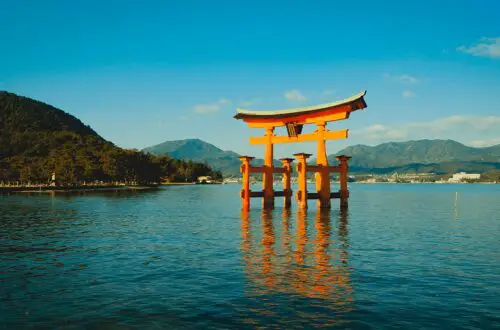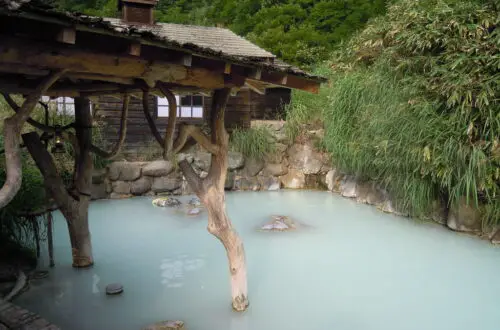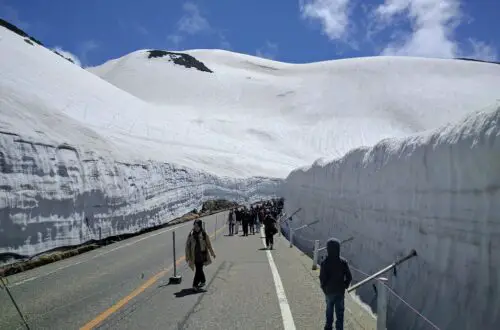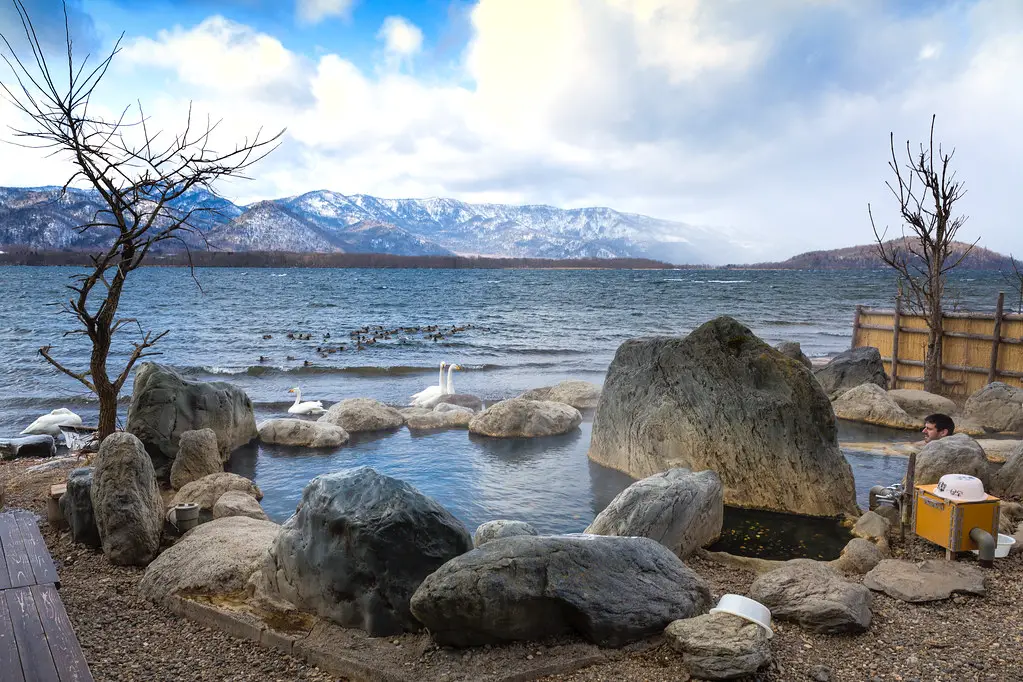
Best Onsen Towns in Japan
Being dotted with volcanic landscapes, Japan is a land of hot springs, aka, onsens. Bathing in the onsen is a national leisure activity in Japan. But which onsen towns can provide the best bathing experience?
The best onsen towns in Japan are:
- Kusatsu, Gunma – Famous for the Yubatake or “hot water field”
- Beppu, Kyushu – An old onsen town offering a variety of bath types and Jigoku (extremely hot springs)
- Arima, Kobe – Famous for onsens with amazing healing properties
- Gero, Gifu – An old onsen town famous for rejuvenating scented alkaline water
- Dogo, Ehime – Famous for the legendary bathhouse Dogo Onsen Honkan

Kusatsu Town, Gunma Prefecture
Despite being famous as ‘Onsen Prefecture’ due to the sheer number of onsen resorts, Gunma Prefecture is still best known for the onsens in Kusatsu. In fact, this town spoils you for choice with numerous hot springs.
A high concentration of sulfur in the acidic water of these springs has antibacterial power and heals body aches and bruises. The locals loving calls the water as a ‘cure for every illness but lovesickness’.
At the center of the town is the Yubatake or “hot water field”. This reservoir of restorative water is the symbol of the town.
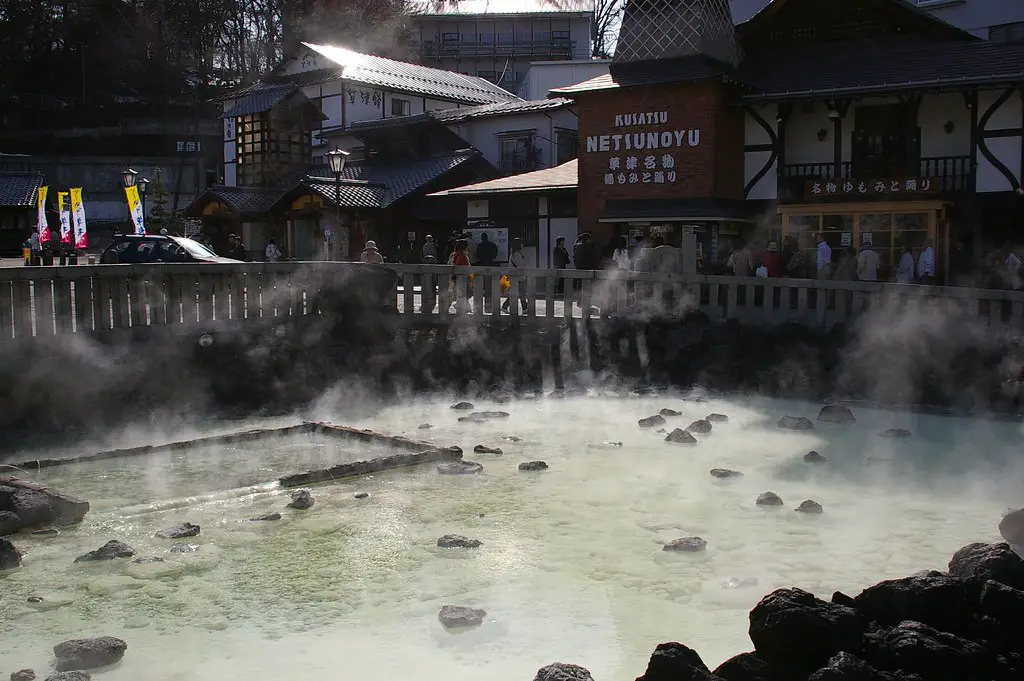
It’s the main source of hot spring water to various ryokans and public baths clustered around it. Before distribution, the water is cooled down in the Yubatake’s wooden conduits by a few degrees.
This process of cooling down is known as Yumomi, involving a group of people hand-stirring the water with wooden planks while singing and dancing.
Also, visitors can watch and join this daily performance in the Netsu No Yu bathhouse, adjacent to Yubatake, for a JPY 500 admission fee.
Famous Hot Springs in Kusatsu
The streets in the Kusatsu are lined with ryokans and public baths but the most famous are these three:
Sainokawara Rotenburo (Bathhouse)
Surrounded by beautiful forest views, this large bathing area can accommodate one hundred people. In fact, it stays open all year round, and each season presents its own unique beauty.
Getting the water supply from the Bandai hot water springs, the acidic chloride sulfate water of this onsen is believed to cure digestive diseases and various chronic conditions.
Address: Oazakusatsu 521-3, Kusatsu Town.
Visit the official website for information about opening hours and fees.
Otakinoyu (Public Bath Facility)
A nice spot for experiencing the awase-yu bathing where you take one bath after another with water temperature being increased gradually.
Drawing acidic sulfate water from the Nikawa onsen, the natural water is said to promote radiant skin.
Address: Oazakusatsu 596-13, Kusatsu Town.
Wanna treat yourself with a little self-care? Then, get more information from the official website.
Gozanoyu (Bathhouse)
This is the best bathing place to have a glimpse of what Kusatsu was like in ancient times because of its design elements from both Edo- and Meiji-period styles. It has two stone and wooden baths that get water supply from Yubatake and Bandai springs, respectively.
The bathhouse offers an exclusive three-hour Yukata de Sanpo course where visitors can experience an authentic onsen adventure while dressed up with traditional Japanese outfits.
Address: Oazakusatsu 421, Kusatsu Town.
Planning to visit there? The official website will help.
Also, tourists can get their onsen fix in several small community bathhouses (some of them are free) and ryokans. In addition, some ryokans allow non-staying visitors for a fee.
Other Attractions
Foot Baths
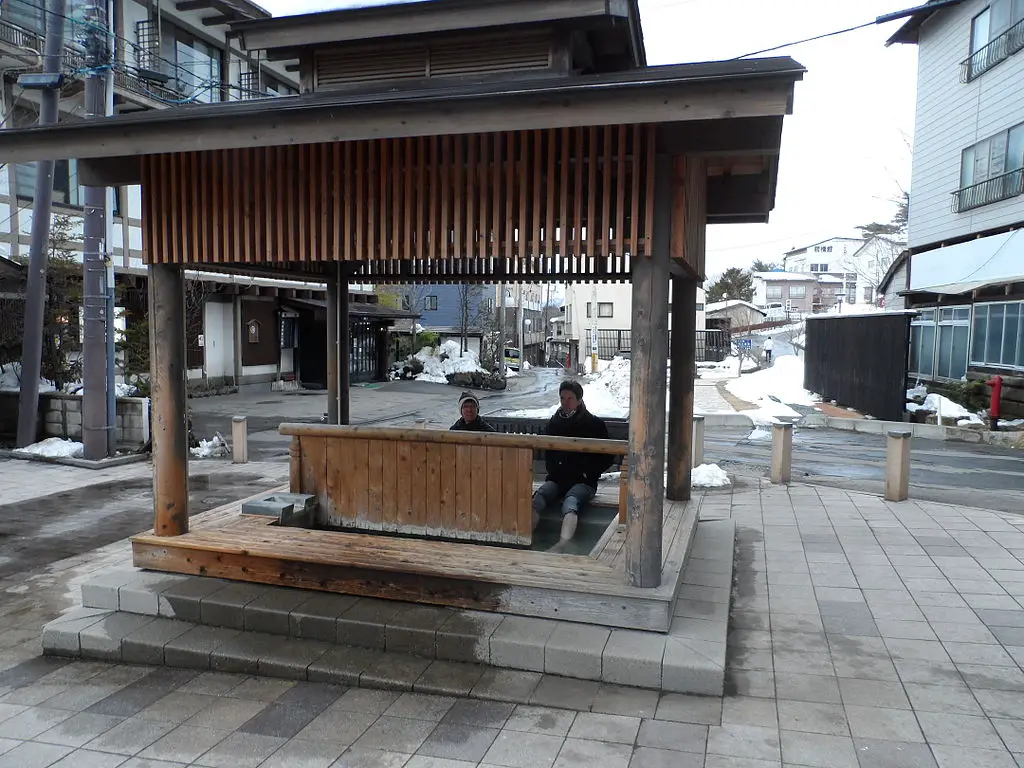
A traditional ashiyu or “foot bath” is another attraction of Kusatsu. You can find a few spots outside the bus terminal building, but Yubatake Souan (a ryokan) next to Yubatake offers it for free upon ordering a meal or drink.
Mount Shirane
Standing just outside the Kusatsu town, this mountain is a series of volcanic peaks. However, its slopes serve as excellent ski trails in winter and hiking routes in other seasons.
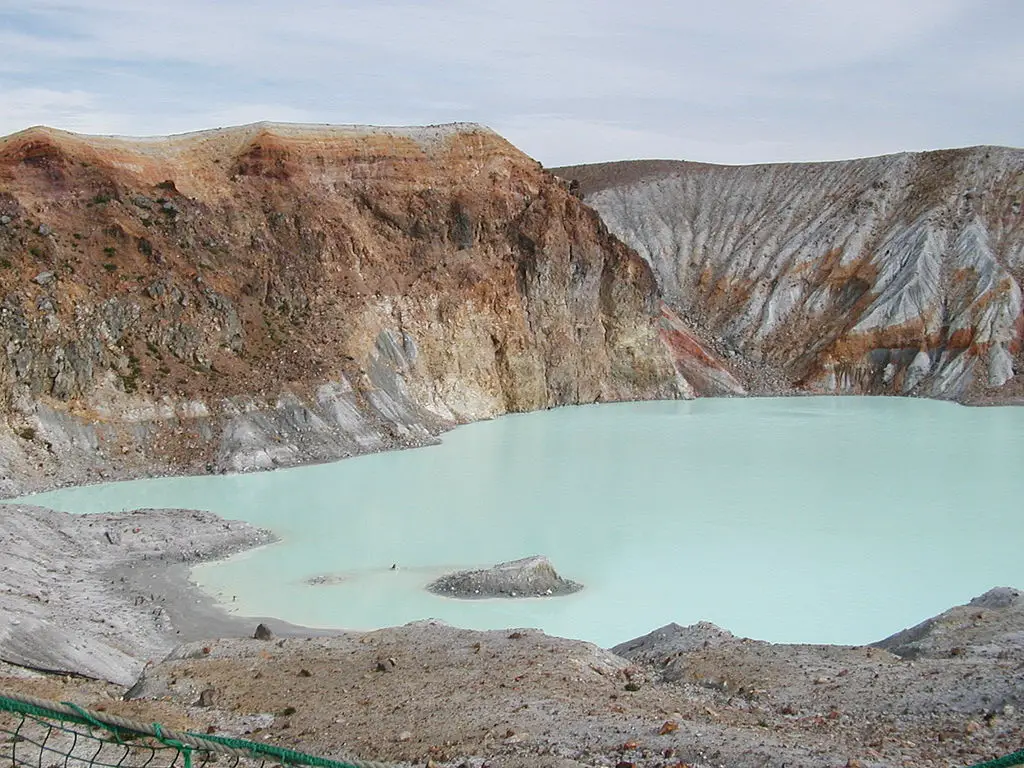
On a slope is the Kusatsu Onsen Ski Resort that is not far from the town’s hot spring baths, which means you can take a relaxing hot soak after hitting the slopes.
How to Go to Kusatsu?
The tranquil nature of the city feels like a thousand miles away from the hustle and bustle of a busy city, but it’s an easy escape from Tokyo. So, the possible routes from Tokyo are:
By Train
- From Tokyo: Take the Joetsu bullet train → Takasaki Station → from there, take a JR Agatsuma line train → Naganohara-Kusatsuguchi Station → take a JR bus to the desired hot spring spot (for JR Pass holders)
- From Tokyo: Ueno Station to Naganohara-Kusatsuguchi Station by taking a Limited Express train → a JR bus to the desired onsen (for no-JR Pass holders)
By Bus
- From Tokyo: Take a JR highway bus from the Shinjuku JR Highway bus terminal to the Naganohara-Kusatsuguchi Station → take the JR Bus Kanto to the Kusatsu Onsen bus terminal → walk to your desired onsen
Check the official website for other possible routes.
Beppu City, Kyushu
Beppu is one of the most famous and oldest onsen towns in Japan. Located in the islands of Kyushu, it has eight springs, each complete with public baths and ryokans. Together these onsens gush the largest volume of hot spring water in the country.
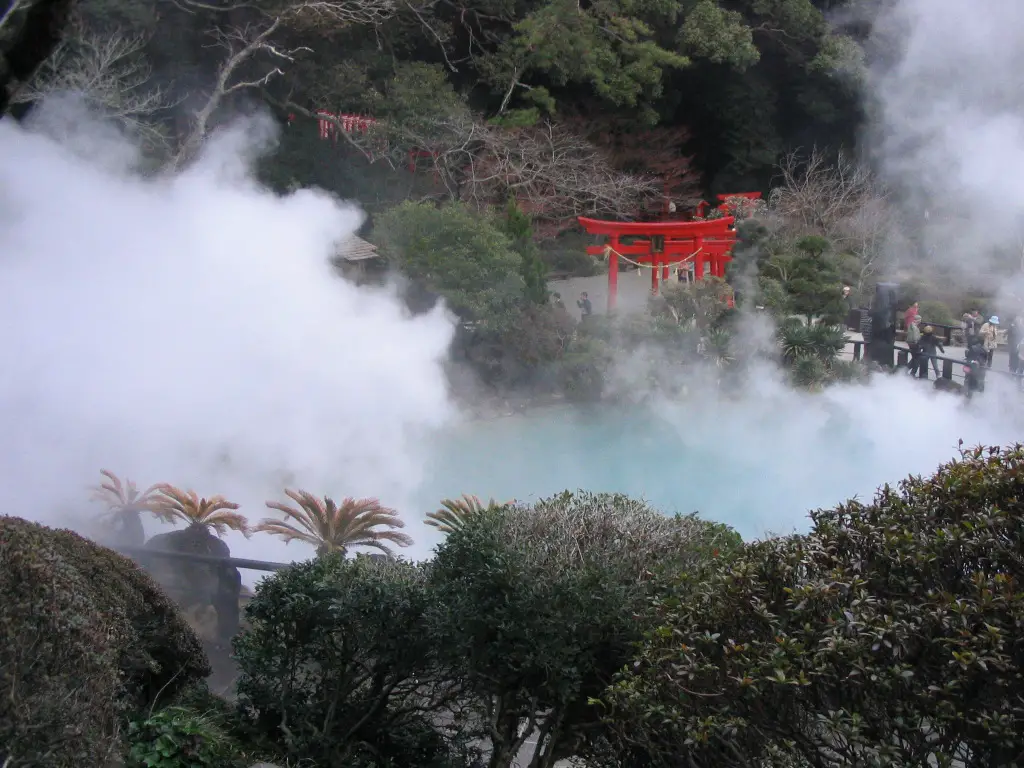
This town could easily be the Mecca for onsen lovers because of the sheer range of bath types it offers. You can enjoy traditional onsen baths and steam baths (from the steam of hot springs). Also, there are sand baths (buried in naturally heated sand), and mud baths (bathing in muddy hot water).
Famous Hot Springs in Beppu
Beppu has several famous public bathhouses and ryokans and some of them provide mud, steam, and sand bath facilities.
Tanayu (A Ryokan Facility)
The Suginoi Hotel is one of the best ryokans in the town. Tanayu is the hotel’s main hot spring facility. The outdoor roof pools offer marvelous and unobtrusive views of the city.
The massive complex also has an Aqua Garden where guests can enjoy a salt sauna, healing bath, and Fango Therapy—a kind of mud bath.
Onsen Hoyo Land (Public Bath)
Go to this public bath complex if you want to enjoy mud and steam baths along with traditional hot spring baths.
There are both indoor and outdoor bathing facilities, with the former option being gender-separated.
Takegawara (Bathhouse)
This famous bathhouse offers sand and regular hot water baths in a surrounding that evokes the nostalgia of a bygone time.
However, the only problem is a part of the complex is surrounded by a red light district.
Looking for a sand bath in a more open place? The Beppu Beach Sand Bath along the coast of Beppu Bay is the place to stop by.
Other Attractions
Jigoku or Hells
The geothermal hot springs are hot tourist attractions and the practice of hopping from one to another is called jigokumeguri.

These steamy onsens are so hot that you cannot bathe there but some have arrangements for ashiyu or “foot dipping”. You can try boiled egg, pudding, and other food made in the heat of the springs.
Beppu Ropeway
Want to watch the numerous Beppu hot springs from a bird’s eye view? This ropeway service will take you to the Tsurumi Mountain peak, offering a vantage point to view the entire Beppu town.
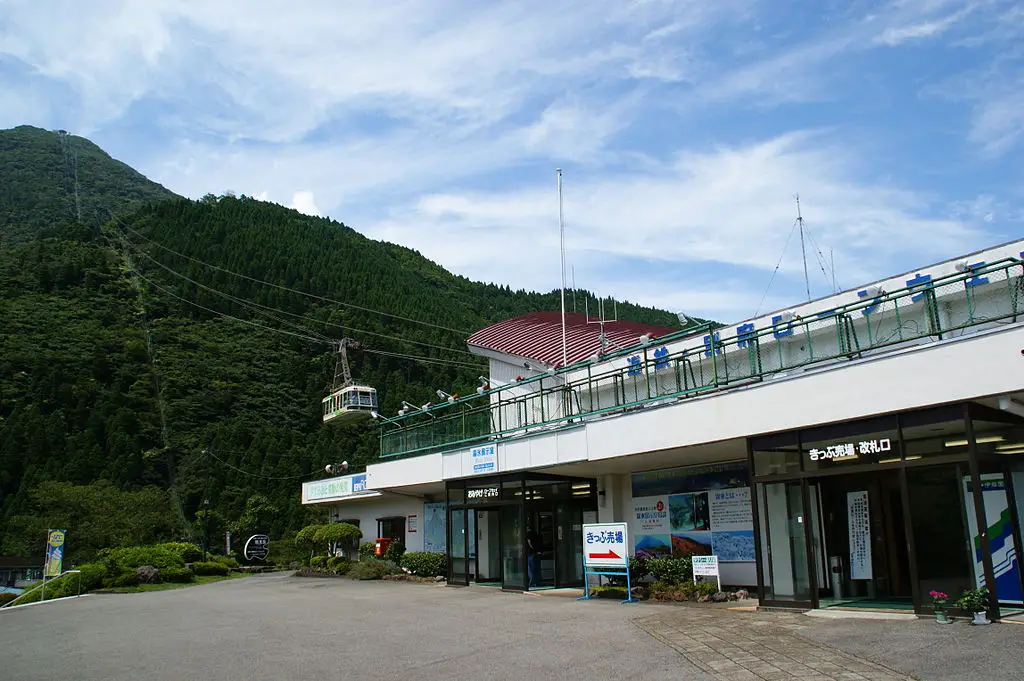
On a clear sunny day, you can see the distant Shikoku Island and even the Chugoku region.
How to Go to Beppu?
By Air
Oita Airport has flight connections to most major cities in Japan. Then, a bus ride to Beppu will take around 40 to 50 minutes.
- Oita Airport → Oita Kotsu Bus → Beppu
By Train
- From Tokyo: Tokaido/Sanyo Shinkansen → Kokura Station → change to the Sonic Limited Express → Beppu Station
- From Osaka: Take a Midosuji Line metro from the Yodoyabashi Station → Shin-Osaka Station → change to Shinkansen Nozomi → Kokura Station → Beppu Station
You can also travel there by bus and ferry, but these journeys will take long hours. Get more information about hot springs, activities, and access to Beppu from the town’s official website.
Arima Town, Kobe
Arima is one of the most ancient and greatest hot spring towns in Japan. The Ministry of Environment recognizes the town’s hot spring water to have 7 out of the 9 healing properties characteristics of Japan’s onsen water.
Despite having many onsens, Arima does not have any nearby volcanoes, a rare natural phenomenon. This mountainous area is famous for having two types of hot spring water:
The Ginsen (silver spring): It is clear water that contains radium and carbonate. These springs are said to boost the immune system and ease joint and muscle ache.
The Kinsen (gold spring): The water in these springs has a red-brown color due to having iron and salt. Bathing here relieves muscle pain and is therapeutic for the skin.
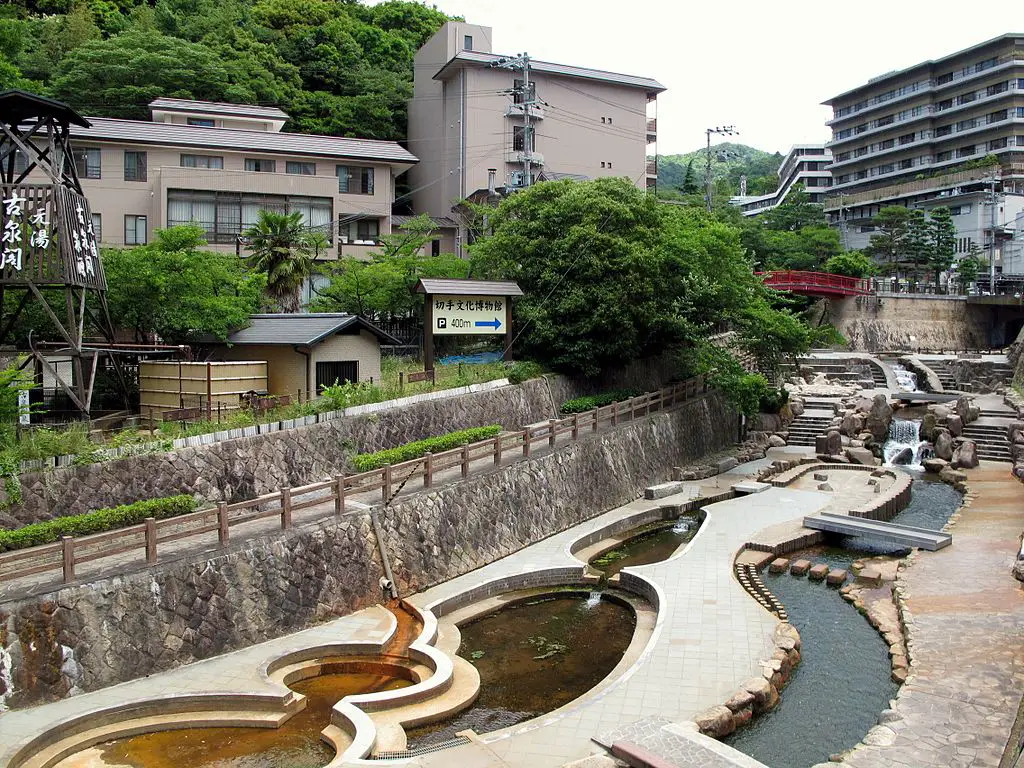
Famous Hot Springs in Arima
The two public bathhouses, Kin no Yu and Gin no Yu, along with one of the town’s oldest ryokans, Goshobo, are worth a visit.
Kin no Yu (Bathhouse)
Being the larger of the two bathhouses, it serves guests with two indoor gold baths. Outside the precinct are Taiko no Ashiyu and Taiko no Insenba, offering free ashiyu or “foot bath” and ginsen drink to the guests, respectively.
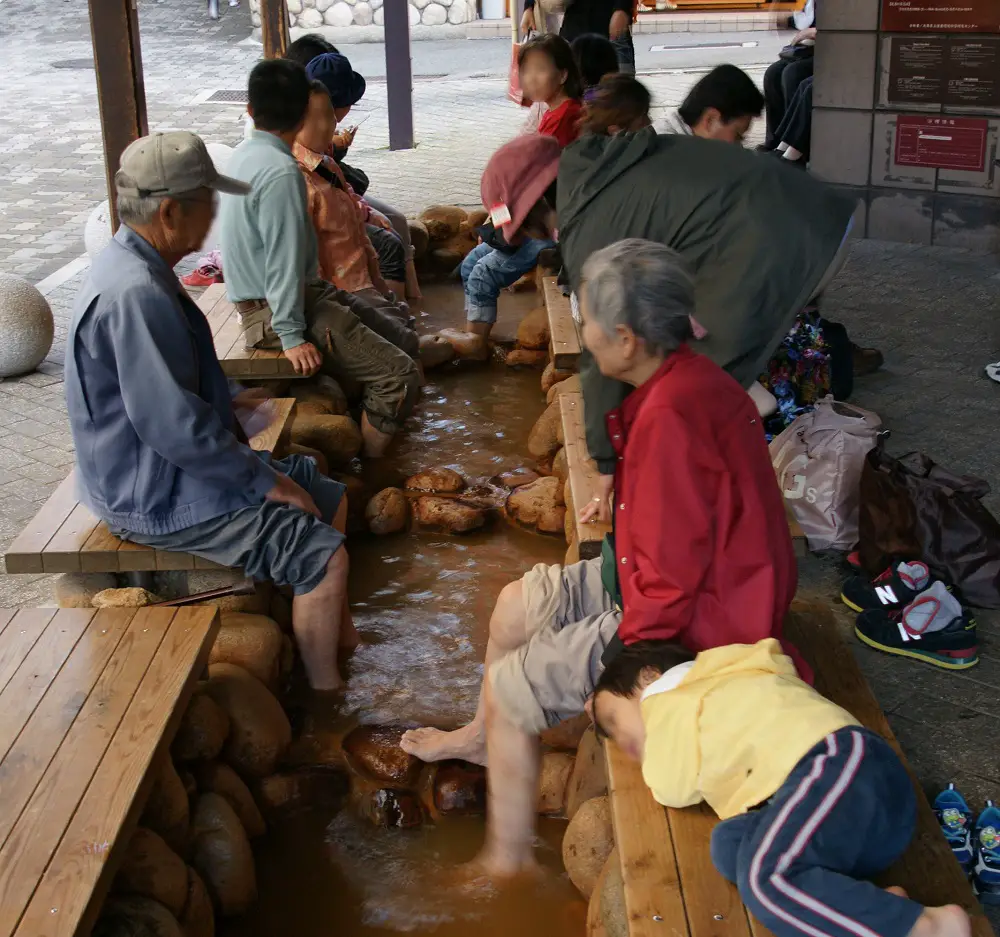
Gin no Yu (Bathhouse)
The bathhouse channels water from the tansan source and combines it with a radium spring to provide the guests with silver-water bathing options.
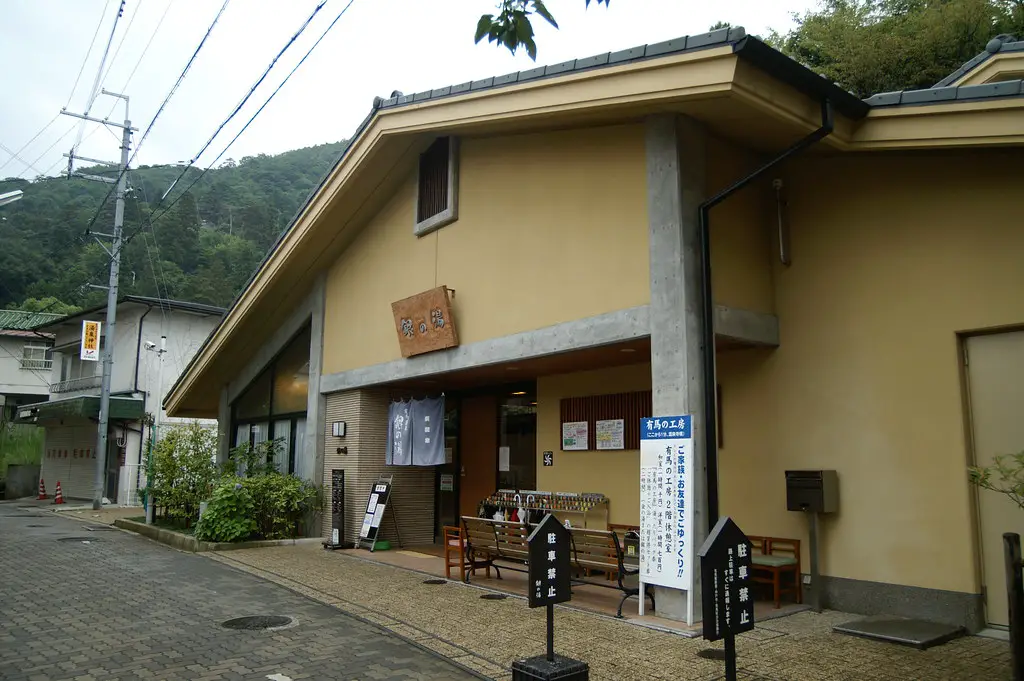
Goshobo (Ryokan)
One of the oldest ryokans in Arima, Goshobo has indoor stone pools for both male and female visitors. Just like Ki no Yu bathhouse, its pools are filled with golden hot spring water.
The town has several other ryokans that are open for non-staying visitors. You can get a day-service for JPY 500 to JPY 2,500.
Other Attractions
You can explore the entire town by foot to visit its nice temples, museums, and parks.
Trekking
There are two trekking courses. One is a long stairway leading to the top of the Mount Ochiba. The second one is a two-hour trek amid the natural forest.
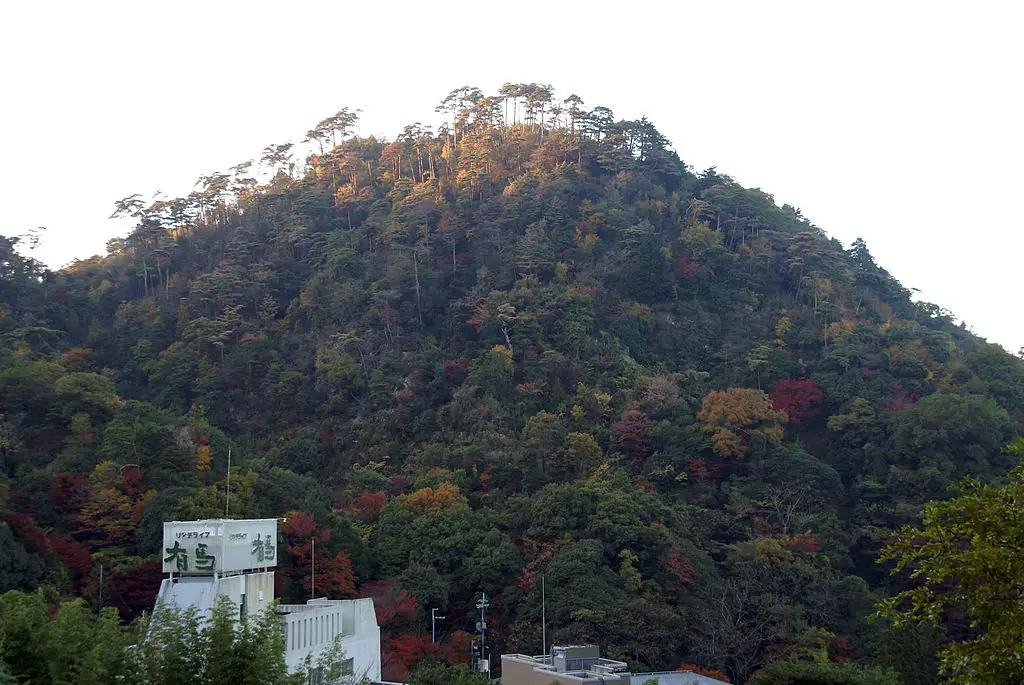
Arima Cider
There are many souvenir shops in Arima, selling a wide variety of onsen-related omiyages or “gifts or souvenirs”. But Arima Cider is unique, something that you won’t find anywhere else. This carbonated onsen water is bubbly, foamy, and quite good for health.
How to Go to Arima?
Arima is easily accessible from major cities like Osaka and Kyoto.
By Air
- Fly to the Kobe Airport → take a train in the Arima Line → Arima Onsen Station
By Train
- From Kyoto: Take JR Tokaido Shinkansen → Hokushin Express → Kobe Electric Railway → Arima Onsen Station
- From Kobe: Take the subway from Sannomiya or Shin-Kobe Station → Tanigami Station → take a Shintetsu Arima-Sanda Line train → Arimaguchi Station → take a Arima Line train → Arima Onsen Station
By Bus
- Direct bus from Kyoto: JR bus from Kyoto Station to Arima Onsen
- Direct bus from Osaka: Hankyu Bus and JR Bus → From Hankyu Umeda Station or JR Osaka Station → Shin-Osaka Station → Arima Onsen
By Cablecar and Ropeway
Enjoy the scenic Mount Rokko views while riding cablecar and ropeway to reach the Arima Onsen.

- To reach the Rokko Cablecar base station: Take a train from Sannomiya Station (Hankyu Kobe Line) → Rokko Station → take Kobe City Bus number 16 → the base station.
- To reach the Arima Onsen: Cablecar ride from the base station → the top station → take the circular bus line → ride the Rokko Ropeway → Arima Onsen
Arima’s official website can provide detailed information about the attractions and other aspects of the town.
Gero City, Gifu
The Confucian poet Hayashi Razan rated it as one of the three best onsens in Japan. The hot springs here have still retained that special quality for which Razan rated them so highly.
The mildly-scented alkaline water of Gero hot springs is said to make skin smooth and radiant. It also energizes your body by reducing fatigue and treating various types of pain.
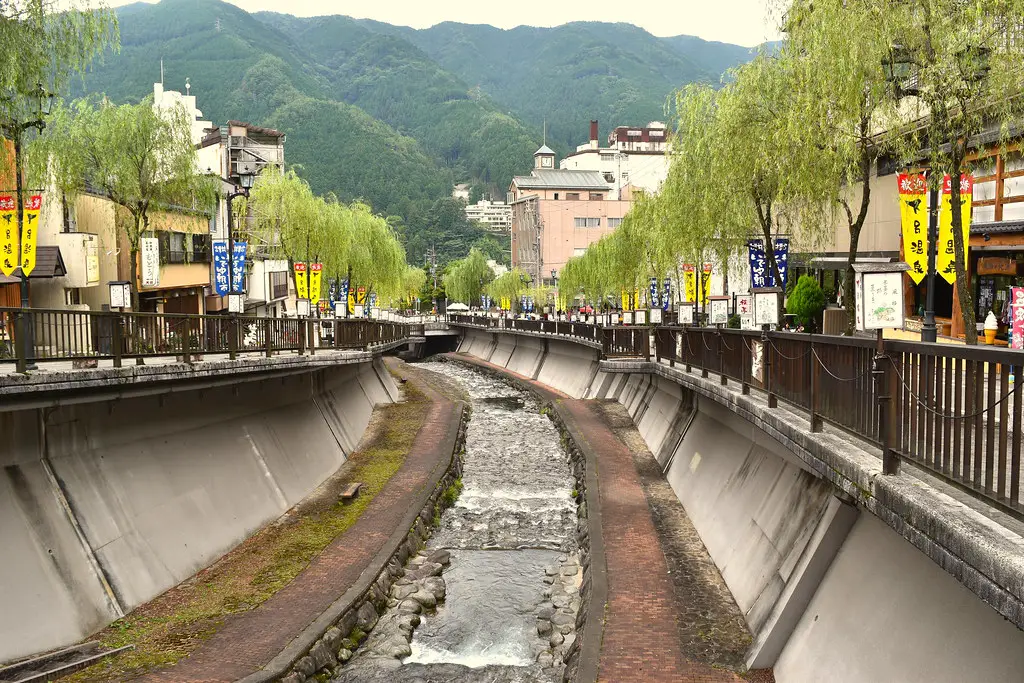
There are three public bathhouses along with spa centers and ryokans in Gero. An open-air bath is there too near the Gero Bridge for free of charge. Free foot bath points are scattered across the city so anyone can unwind after strolling around.
Yumeguri Tegata (Onsen Pass)
Want to visit more than one hot spring spot? Purchase a Yumeguri Tegata. It’s an onsen pass (a wooden tablet) that you can purchase at any ryokan, convenience store, souvenir shop, or the information center outside JR Gero station for JPY 1,300.
With a validity of six months, you can use it for three visits to the participating ryokans.
Famous Hot Springs in Gero
Like any other onsen town, Gero is dotted with various spas, ryokans, and public bathing spots. Here are the ones that are worthy of your visit:
Sachi no Yu (Spa)
Sachi no Yu is one of the top three spas in Gero. Its facilities are quite unique because of the arrangements of seven types of baths. You can take an indoor hot spring bath, open-air bath, sauna, waterfall shower, and more. Couples and families with kids can use the family bath.
The water of these spas hold various healing and regenerating properties. It improves the skin, helps to regain energy after an illness, and treats nervous numbness and various physical pains.
Sasara (Hotel and Spa)
Wanna get a glimpse of the country’s magnificent past while sinking into relaxing hot spring water? Sasara hotel is the exact place you would want to visit. It’s a perfect place for those looking for whole body rejuvenation.
The hotel’s antique-style interiors take design cues from the Taisho period, featuring a fusion between traditional Japanese and western arts. You can enjoy the decorations while taking an indoor bath. In addition, an open-air is available too.
If you want both outdoor views and privacy, bathe in the private open-air stump tub carved from an old tree. There is also a stone sauna and a healing salon if you want something different.
Funsenchi (Open-air Public Bath)
Nearby the Gero Bridge on the riverside of Hida River, this large rotenburo or “open-air bath” is open for all at free of cost. Being a public spot, you will get no privacy, no gender-specific bathing option, and no staff support.

However, with a large sky above your head and nice surrounding views, this is a great option for free onsen bathing.
Other Attractions
If you want to explore a few more attractions other than onsen bathing, visit these places:
Onsen Gassho Mura (A Village)
This village is actually an open-air museum designed after the gassho-style houses. The whole area is scattered with gasshozukuri farmhouses that feature the distinctive thatched gable roof with steep slopes at about a 60-degree angle.
Inside the village precinct is a komaino (lion-dogs that guard the entrance of a sacred place) museum. Besides exploring the interiors of these houses, tourists can enjoy artist performances. They can also be active participants in traditional folk art.
Onsenji Temple
This temple is dedicated to the worshiping of the Yakushi Nyorai (Buddha of healing). A huge earthquake once blocked the flow of onsen water in the town. Locals believe that it was the Buddha who brought water to the dry hot springs.
The temple has a stone staircase up to its entrance. Climbing on it presents delightful views of the Hida River and the town.
Gero is also famous for its own Kobe beef called Hida-gyu. Don’t forget to taste this delicacy. Also, this area holds fireworks and festivals in various seasons.
How to Go to Gero?
Gero is located between Nagoya and Takayama, taking a short trip from any of these cities. Journeying from big cities like Tokyo or Osaka requires stopping at either Nagoya or Takayama. Then, you can take a train or bus to reach Gero.
Many hotels and spas provide their own shuttle bus service (usually at free of charge) for their guests. Contact them and book in advance to get that service from Nagoya.
By Train
From Tokyo: JR Shinkansen Nozomi or Shinkansen Kodama → Nagoya → JR Hida limited express → Gero
From Osaka: Shin Osaka → JR Tokaido Shinkansen → Nagoya → take JR Hida limited express → Gero
By Bus
From Tokyo: Take an (S) Shinjuku Line subway from Ichigaya → Shinjuku Expressway bus terminal → take a bus to Takayama bus terminal → take another bus to Gero Nokyomae
From Osaka: Take a bus from Osaka Higashi-Umeda boarding point → Takayama bus terminal → take another bus to Gero Nokyomae
To get more information about sightseeing, events, and hot spring spots, visit Gero Onsen’s official website.
Dogo Town, Ehime
Located in the Ehime prefecture, Dogo is considered to be the oldest onsen in Japan, boasting a history dated back to 3,000 years. For centuries, it has been a hotspot for local travelers.
The town has also started catching the attention of foreigners who love to visit the legendary bathhouse Dogo Onsen Honkan and many ryokans.

Japan’s most exalted and powerful guests, the Imperial Family, make frequent visits to this onsen. Perhaps, the Royal Family too cannot avoid this onsen’s mystical power of dissolving stresses and rejuvenating the body and mind.
Famous Hot Springs in Dogo
The town has a few public bathing places and several ryokans but the most famous among them are:
Dogo Onsen Honkan (Bathhouse)
The large, castle-like bathhouse is the symbol of the town. Constructed in 1894, the multi-leveled complex is a favorite gathering place for locals. You will see traditional design elements on the exterior of the wooden structure. For example, there is a white heron on the top of the Shinro-kaku (white watchtower).
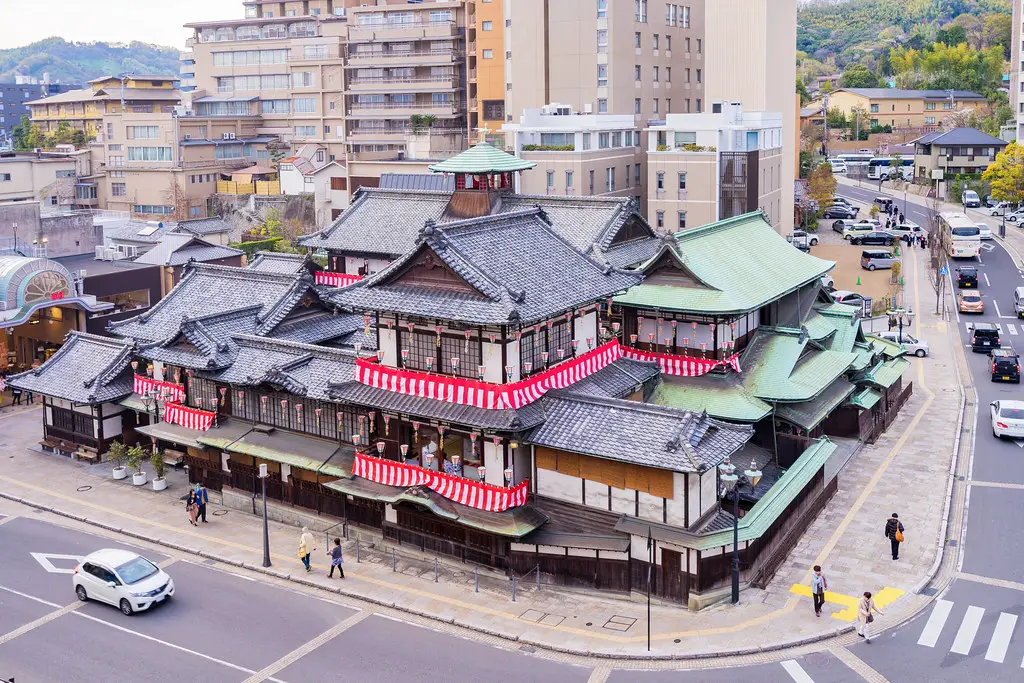
Hayao Miyazaki fans can readily recognize the main onsen building. It was the main backdrop of his award-winning magical film Spirited Away.
When open, the Honkan always remains crowded. You will see hordes of bathers and their accompanying staff in the maze of stairways and passages.
There are two indoor old-fashioned public baths made of stone. The larger Kami no Yu is more crowded and the smaller Tama no Yu is rather serene in nature.
Four different packages at various price points are available and some plans include snacks and refreshing green tea. The most expensive package allows visitors to take a look at the exclusive bathing facility, called Yushinden, reserved for the Imperial Family members.

On the second floor are large communal tatami rooms for the bathers to take a rest and have a snack. However, choose any of the rooms on the third floor if you prefer to do that in private.
Visit the Honkan’s official website for more information.
Asuka no Yu (Bathhouse)
If you are looking for a more modern bathing facility, then move 100 meters away from the Honkan. There stands the Asuka no Yu, the latest Dogo Onsen bathhouse, which is a more contemporary version of the Honkan. You will love this if you feel more comfortable using a private bath and resting in a private room.
The bathing packages are similar to those of the Honkan and the cheapest one starts from JPY 610.
Other Attractions
When you are not spending your time in a hot bath, stroll around the town’s streets and visit these places:
Shopping Arcade
Dogo Haikara Dori is a 250-meter long street adjacent to the Dogo Onsen Honkan. By connecting the Honkan with the Dogo Station, this shopping street has souvenir shops and eateries.
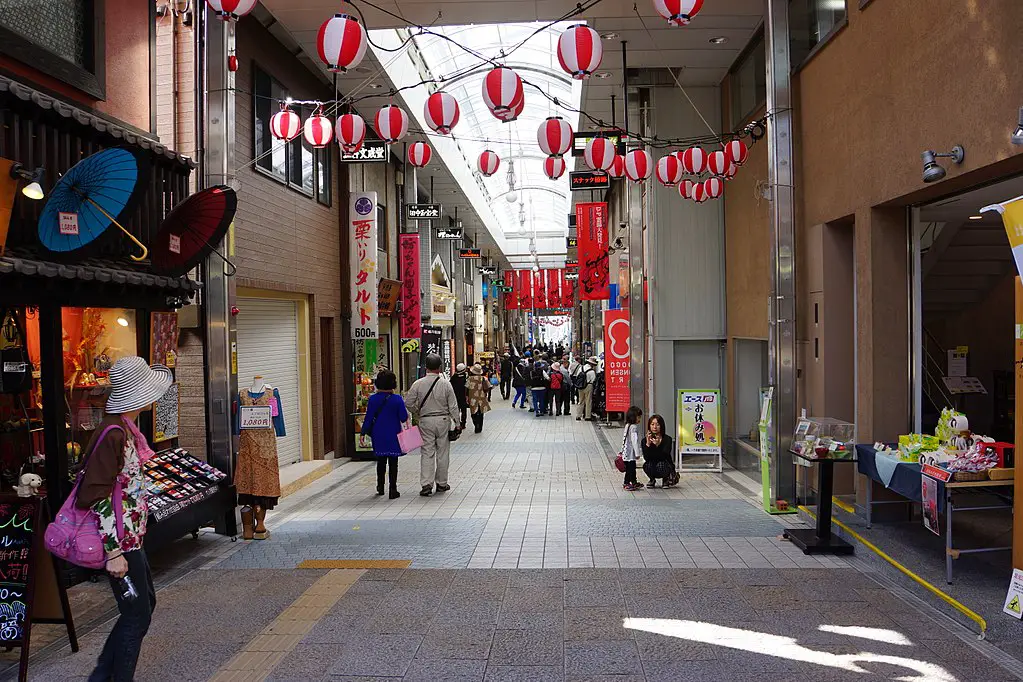
The arcade stays open from 9 AM to 10 PM when you will often see locals and tourists strolling around the street wearing Yukata robe.
Ishiteji Temple
You may take an interest in visiting the most famous temple in Matsuyama since the admission is free.
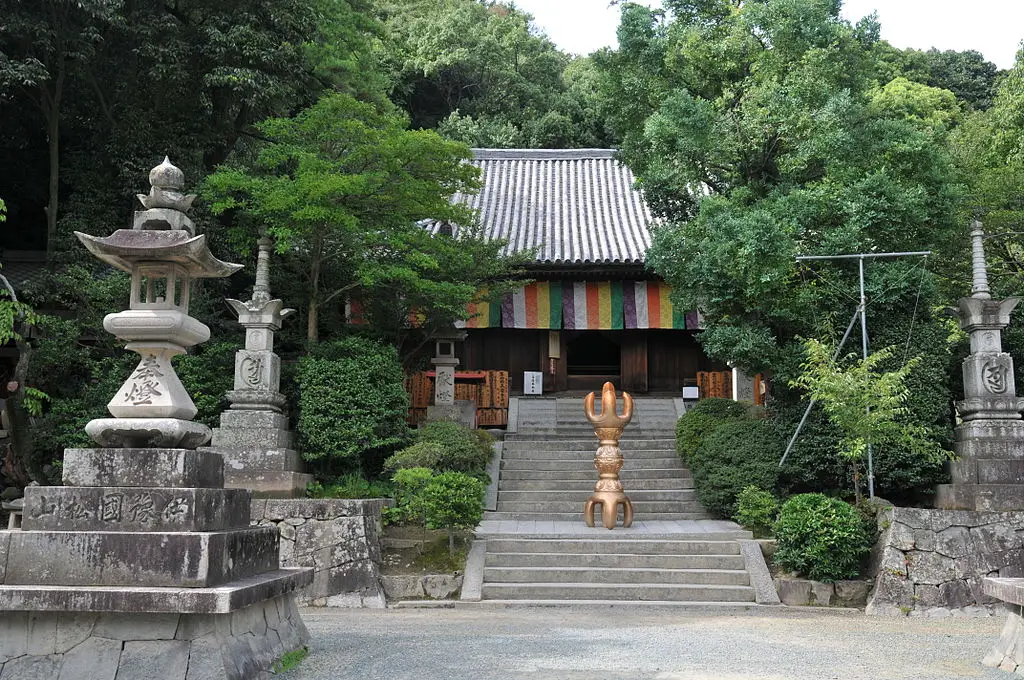
A 20-minute walk from the Dogo Onsen (a bus ride is available too) will take you to this temple, which accommodates several buildings. There are a pagoda and a cave that is the entrance to another temple complex.
How to Go to Dogo?
By Air
- Haneda Airport (Tokyo) or Osaka International Airport (Osaka) → Matsuyama Airport → Iyotetsu Shuttle Bus or cab → Dogo
The bus journey will take around 40 minutes while taking a taxi will be faster, around 10 minutes.
By Train
- From Tokyo: Take the JR Tokaido/Sanyo Shinkansen → Okayama → transfer to the JR Shiokaze limited express → Matsuyama Station → Bus (23 minutes), Iyo Tramway no. 5 (28 minutes), or cab (5 minutes) → Dogo Onsen Honkan
- From Osaka: From Shin Osaka → Shinkansen Nozomi or Shinkansen Kodama → Okayama → Matsuyama Station → Bus (23 minutes), Iyo Tramway no. 5 (28 minutes), or cab (5 minutes) → Dogo Onsen Honkan
For more information, check the official website.
Conclusion
Japan is dotted with onsen towns and these are some of the best picks. These towns offer wonderful onsen bathing experience along with fun things to do. Soaking into the mineral-rich and therapeutic water will not only heal your body but give you the cherishable lifetime memories.


